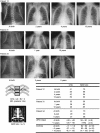Comprehensive clinical studies in 34 patients with molecularly defined UPD(14)pat and related conditions (Kagami-Ogata syndrome)
- PMID: 25689926
- PMCID: PMC4613461
- DOI: 10.1038/ejhg.2015.13
Comprehensive clinical studies in 34 patients with molecularly defined UPD(14)pat and related conditions (Kagami-Ogata syndrome)
Abstract
Paternal uniparental disomy 14 (UPD(14)pat) and epimutations and microdeletions affecting the maternally derived 14q32.2 imprinted region lead to a unique constellation of clinical features such as facial abnormalities, small bell-shaped thorax with a coat-hanger appearance of the ribs, abdominal wall defects, placentomegaly, and polyhydramnios. In this study, we performed comprehensive clinical studies in patients with UPD(14)pat (n=23), epimutations (n=5), and microdeletions (n=6), and revealed several notable findings. First, a unique facial appearance with full cheeks and a protruding philtrum and distinctive chest roentgenograms with increased coat-hanger angles to the ribs constituted the pathognomonic features from infancy through childhood. Second, birth size was well preserved, with a median birth length of ±0 SD (range, -1.7 to +3.0 SD) and a median birth weight of +2.3 SD (range, +0.1 to +8.8 SD). Third, developmental delay and/or intellectual disability was invariably present, with a median developmental/intellectual quotient of 55 (range, 29-70). Fourth, hepatoblastoma was identified in three infantile patients (8.8%), and histological examination in two patients showed a poorly differentiated embryonal hepatoblastoma with focal macrotrabecular lesions and well-differentiated hepatoblastoma, respectively. These findings suggest the necessity of an adequate support for developmental delay and periodical screening for hepatoblastoma in the affected patients, and some phenotypic overlap between UPD(14)pat and related conditions and Beckwith-Wiedemann syndrome. On the basis of our previous and present studies that have made a significant contribution to the clarification of underlying (epi)genetic factors and the definition of clinical findings, we propose the name 'Kagami-Ogata syndrome' for UPD(14)pat and related conditions.
Figures





Similar articles
-
[Kagami-Ogata Syndrome: An Anomaly of the Ribs as a Pathognomonic Feature for the Clinical Diagnosis of an (epi)Genetic Syndrome].Z Geburtshilfe Neonatol. 2020 Jun;224(3):153-159. doi: 10.1055/a-1046-1424. Epub 2019 Dec 18. Z Geburtshilfe Neonatol. 2020. PMID: 31853915 German.
-
Kagami-Ogata syndrome: a clinically recognizable upd(14)pat and related disorder affecting the chromosome 14q32.2 imprinted region.J Hum Genet. 2016 Feb;61(2):87-94. doi: 10.1038/jhg.2015.113. Epub 2015 Sep 17. J Hum Genet. 2016. PMID: 26377239 Free PMC article. Review.
-
Kagami-Ogata syndrome: an important differential diagnosis to Beckwith-Wiedemann syndrome.J Clin Ultrasound. 2020 May;48(4):240-243. doi: 10.1002/jcu.22815. Epub 2020 Jan 28. J Clin Ultrasound. 2020. PMID: 31994200
-
Prenatal diagnosis of Kagami-Ogata syndrome.J Clin Ultrasound. 2021 Jun;49(5):498-501. doi: 10.1002/jcu.22942. Epub 2020 Nov 12. J Clin Ultrasound. 2021. PMID: 33179779
-
Segmental and full paternal isodisomy for chromosome 14 in three patients: narrowing the critical region and implication for the clinical features.Am J Med Genet A. 2005 Oct 1;138A(2):127-32. doi: 10.1002/ajmg.a.30941. Am J Med Genet A. 2005. PMID: 16152632 Review.
Cited by
-
Multi-locus imprinting disturbance (MLID): interim joint statement for clinical and molecular diagnosis.Clin Epigenetics. 2024 Aug 1;16(1):99. doi: 10.1186/s13148-024-01713-y. Clin Epigenetics. 2024. PMID: 39090763 Free PMC article. Review.
-
Dlk1-Dio3 locus-derived lncRNAs perpetuate postmitotic motor neuron cell fate and subtype identity.Elife. 2018 Oct 12;7:e38080. doi: 10.7554/eLife.38080. Elife. 2018. PMID: 30311912 Free PMC article.
-
Exploration of hydroxymethylation in Kagami-Ogata syndrome caused by hypermethylation of imprinting control regions.Clin Epigenetics. 2015 Aug 28;7(1):90. doi: 10.1186/s13148-015-0124-y. eCollection 2015. Clin Epigenetics. 2015. PMID: 26322139 Free PMC article.
-
Paternal uniparental disomy for chromosome 14: prenatal management.BMJ Case Rep. 2019 Dec 30;12(12):e231705. doi: 10.1136/bcr-2019-231705. BMJ Case Rep. 2019. PMID: 31892621 Free PMC article.
-
The contribution of imprinted genes to neurodevelopmental and neuropsychiatric disorders.Transl Psychiatry. 2022 May 21;12(1):210. doi: 10.1038/s41398-022-01972-4. Transl Psychiatry. 2022. PMID: 35597773 Free PMC article. Review.
References
-
- 1da Rocha ST, Edwards CA, Ito M, Ogata T, Ferguson-Smith AC: Genomic imprinting at the mammalian Dlk1-Dio3 domain. Trends Genet 2008; 24: 306–316. - PubMed
-
- 2Kagami M, Sekita Y, Nishimura G et al: Deletions and epimutations affecting the human 14q32.2 imprinted region in individuals with paternal and maternal upd(14)-like phenotypes. Nat Genet 2008; 40: 237–242. - PubMed
-
- 5Hoffmann K, Heller R: Uniparental disomies 7 and 14. Best Pract Res Clin Endocrinol Metab 2011; 25: 77–100. - PubMed
Publication types
MeSH terms
Supplementary concepts
LinkOut - more resources
Full Text Sources
Other Literature Sources
Medical

